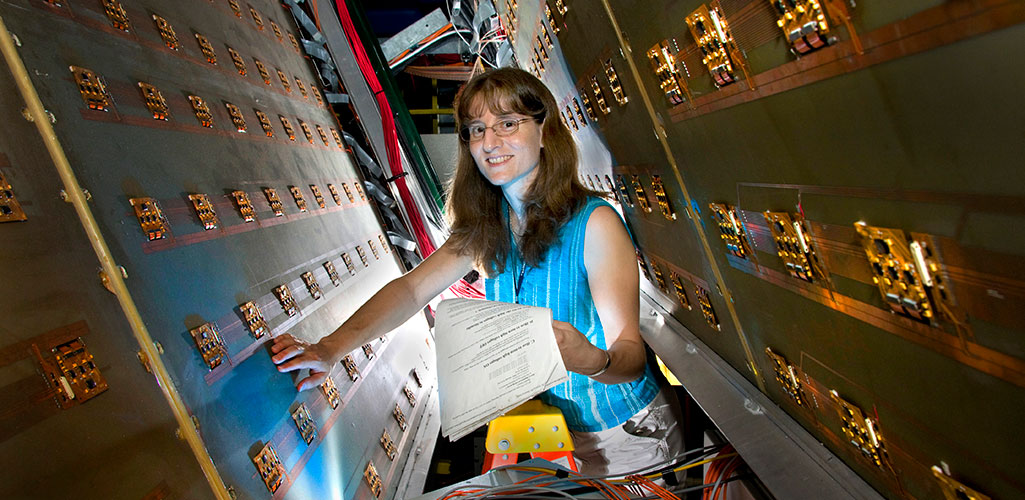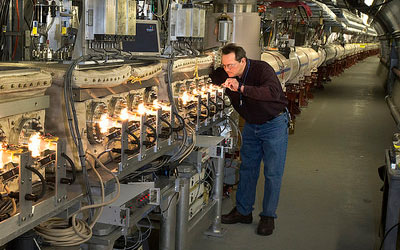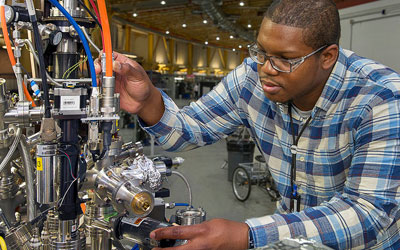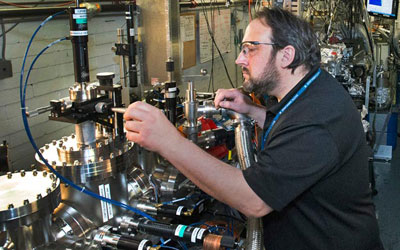Accelerators for Basic Research
Investigating the physical world and the fundamental processes that govern it

Brookhaven National Laboratory excels at the design, construction, and operation of large-scale accelerator facilities, a tradition that started with the Cosmotron and continues today with the Relativistic Heavy Ion Collider (RHIC) complex and the National Synchrotron Light Source II (NSLS-II). Facilities targeted at specific R&D needs include the Accelerator Test Facility (ATF) and the NASA Space Radiation Laboratory (NSRL). Each of these facilities supports a core scientific mission that advances our understanding of the physical world and the fundamental processes that govern it.

Relativistic Heavy Ion Collider
RHIC accelerates various ions (from protons to heavy nuclei such as gold) and collides them to create conditions that allowed scientists to discover and then explore a new state of matter formed by the free movement of quarks and gluons, the most fundamental building blocks of matter. This form of matter, called quark-gluon plasma, last existed microseconds after the Big Bang, the start of the universe. RHIC achieved record-breaking collision rates with novel beam-cooling techniques using high-frequency feedback technologies and by using intense electron beams to focus the colliding ion beams. The next generation of beam-cooling techniques are currently under development at RHIC, which will help to lay the foundation for a proposed future Electron-Ion Collider. Such an Electron-Ion Collider will allow a deeper exploration of the internal structure of the visible matter that forms our universe.

National Synchrotron Light Source II
The National Synchrotron Light Source II (NSLS-II) enables scientists to observe fundamental properties with nanometer-scale resolution and atomic sensitivity. The facility offers a wide spectrum of experimental techniques to study these properties, including nanoscale imaging, high-resolution x-ray diffraction, and various forms of x-ray spectroscopy. Each of NSLS-II’s 28 operating beamlines can help scientists uncover the structure, chemistry, morphology, and other properties of various materials from large-scale structures to their nanometer-scale building blocks.

Accelerator Test Facility
The Accelerator Test Facility (ATF) user program supports developments in fundamental accelerator and laser science that may yield next generation capabilities to address national needs. User-driven basic science research at ATF spans the study of novel particle acceleration techniques that can lead to smaller and more cost-effective accelerators; the study of techniques to provide high-brightness radiation sources, ranging from terahertz radiation to x-ray sources; development of next-generation ion generation and acceleration techniques; the study of laser processes that may lead to more compact particle accelerators; and the study of ultrafast electron diffraction and microscopy techniques. Examples of the cutting-edge user research at ATF include free electron laser techniques, the study of Compton scattering as a high energy x-ray source, the demonstration of direct laser acceleration, and unique studies of laser-driven ion generation and acceleration.
Other Facilities Supporting Basic Research
Brookhaven Linac Isotope Producer
BLIP uses its unique production and radiochemistry laboratories to perform research in the development of radioisotopes for medical research, and also industrial radioactive isotopes that are generally not available elsewhere.
Superconducting Magnet Division
Superconducting magnets developed by the Superconducting Magnet Division (SMD) have been used in accelerators that explore the fundamental particles and forces of the universe, including Brookhaven's Relativistic Heavy Ion Collider and the Large Hadron Collider at Europe’s CERN laboratory. Such magnets would also be essential to building an Electron-Ion Collider, a proposed future facility for unlocking the secrets of the strongest force in nature. SMD scientists also study the fundamental behavior of the superconducting materials themselves, as well as cables and magnets made from these materials. SMD has been at the forefront of studying the behavior of high-temperature superconductors (HTS)—superconductors that operate at higher temperatures or create higher fields than conventional metal-based superconductors—and is a world leader in the design of high-field HTS magnets.
Instrumentation Department
Activities at the forefront of technology require a fundamental understanding of the chemistry and physics involved in the process under development. An example of this type of research in Brookhaven’s Instrumentation Department is our cathode work: We use the National Synchrotron Light Source II and Cornell’s High Energy Synchrotron Source to conduct in-situ x-ray studies of photocathode materials used to generate particle beams. Similarly, we carry out studies to understand the behavior and performance of our systems in extreme conditions, e.g. in high-radiation environments and at extremely cold (cryogenic) temperatures. Quantum Information Science is our newest research effort.
Tandem Van de Graaff
Brookhaven’s Tandem Van de Graaffs are the largest operational electrostatic accelerators in North America. They have been used for basic research in nuclear physics experiments in the past, including as an injector for the Lab’s Relativistic Heavy Ion Collider (RHIC). Today the Tandems focus on applied research and industrial applications.
Accelerator Center for Energy Research
Core ACER activities include: (1) Investigating the molecular fragments created when solutions are irradiated and understanding how these fragments react to produce longer-lived reactants, and (2) Using those reactants to study the details of chemical reactions (for example, the thermodynamics, rates, and reaction mechanisms of charge transfer systems)—particularly in reactions underlying important energy technologies such as nuclear energy and converting sunlight to fuels.
NASA Space Radiation Laboratory
The bulk of the research solicited and supported by NASA at the NASA Space Radiation Laboratory is singly focused on understanding the risks posed by space radiation to biological systems and on finding possible countermeasures. Those requesting beam time are generally recipients of NASA grants whose research has already been reviewed and approved by NASA. A Brookhaven-Lab-based committee reviews the beam-time proposals and recommends beam time based on feasibility and other institutional considerations. Basic research can be carried out at NSRL by non-NASA users who pay for beam time on a full cost-recovery basis.



